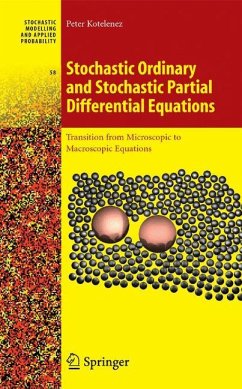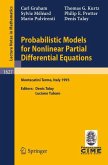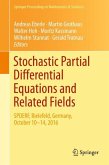The present volume analyzes mathematical models of time-dependent physical p- nomena on three levels: microscopic, mesoscopic, and macroscopic. We provide a rigorous derivation of each level from the preceding level and the resulting me- scopic equations are analyzed in detail. Following Haken (1983, Sect. 1. 11. 6) we deal, "at the microscopic level, with individual atoms or molecules, described by their positions, velocities, and mutual interactions. At the mesoscopic level, we describe the liquid by means of ensembles of many atoms or molecules. The - tension of such an ensemble is assumed large compared to interatomic distances but small compared to the evolving macroscopic pattern. . . . At the macroscopic level we wish to study the corresponding spatial patterns. " Typically, at the mac- scopic level, the systems under consideration are treated as spatially continuous systems such as ?uids or a continuous distribution of some chemical reactants, etc. Incontrast,onthemicroscopiclevel,Newtonianmechanicsgovernstheequationsof 1 motion of the individual atoms or molecules. These equations are cast in the form 2 of systems of deterministic coupled nonlinear oscillators. The mesoscopic level is probabilistic in nature and many models may be faithfully described by stochastic 3 ordinary and stochastic partial differential equations (SODEs and SPDEs), where the latter are de?ned on a continuum. The macroscopic level is described by ti- dependent partial differential equations (PDE's) and its generalization and simpl- cations. In our mathematical framework we talk of particles instead of atoms and mo- cules. The transition from the microscopic description to a mesoscopic (i. e.
From the reviews:
"This book treats the transition from microscopic to macroscopic equations for particle systems. ... Peter Kotelenez ... has written a monograph in which he rigorously constructs the theory of correlated Brownian motion in interacting particle systems. ... Researchers working on interacting particle systems and probability theory will definitely find this book very useful." (J. Dubbeldam, Kwantitatieve Methoden, Issue R11, 2008)
"This interesting book treats in detail stochastic partial differential equations (SPDEs) describing mass distribution of particles. The book introduces in an essentially self-contained manner the author's research on the evolution of large particles interacting with an environment consisting, for instance, of small particles. ... To help the reader, the book devotes four of the fourteen chapters to the more lengthy proofs of some theorems. ... the reviewer recommends this book to any researcher interested in SPDEs." (Carlos M. Mora González, Mathematical Reviews, Issue 2009 h)
"The monography under review presents mathematical models for physical dynamical systems of particle and mass evolution on different levels ... . Extremely helpful are the excellent summaries at the beginning of each chapter. ... This monography is a highly impressive result of many years of concise scientific studies on SODEs, SPDEs and mathematical physics. I warmly recommend this book for scientific and personal enlightenment to graduate students ... as well as to mathematical scientists in mathematical physics, theoretical physics and mathematical biology." (Michael Högele, Zentralblatt MATH, Vol. 1159, 2009)
"This book treats the transition from microscopic to macroscopic equations for particle systems. ... Peter Kotelenez ... has written a monograph in which he rigorously constructs the theory of correlated Brownian motion in interacting particle systems. ... Researchers working on interacting particle systems and probability theory will definitely find this book very useful." (J. Dubbeldam, Kwantitatieve Methoden, Issue R11, 2008)
"This interesting book treats in detail stochastic partial differential equations (SPDEs) describing mass distribution of particles. The book introduces in an essentially self-contained manner the author's research on the evolution of large particles interacting with an environment consisting, for instance, of small particles. ... To help the reader, the book devotes four of the fourteen chapters to the more lengthy proofs of some theorems. ... the reviewer recommends this book to any researcher interested in SPDEs." (Carlos M. Mora González, Mathematical Reviews, Issue 2009 h)
"The monography under review presents mathematical models for physical dynamical systems of particle and mass evolution on different levels ... . Extremely helpful are the excellent summaries at the beginning of each chapter. ... This monography is a highly impressive result of many years of concise scientific studies on SODEs, SPDEs and mathematical physics. I warmly recommend this book for scientific and personal enlightenment to graduate students ... as well as to mathematical scientists in mathematical physics, theoretical physics and mathematical biology." (Michael Högele, Zentralblatt MATH, Vol. 1159, 2009)









